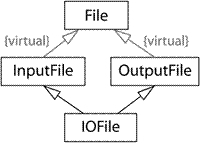觸及 multiple inheritance (MI)(多繼承)的時候,C++ 社區就會鮮明地分裂為兩個基本的陣營。一個陣營認為如果 single inheritance (SI)(單繼承)是有好處的,multiple inheritance(多繼承)一定更有好處。另一個陣營認為 single inheritance(單繼承)有好處,但是多繼承引起的麻煩使它得不償失。在本文中,我們的主要目的是理解在 MI 問題上的這兩種看法。
首要的事情之一是要承認當將 MI 引入設計領域時,就有可能從多於一個的 base class(基類)中繼承相同的名字(例如,函數,typedef,等等)。這就為歧義性提供了新的時機。例如:
class BorrowableItem { // something a library lets you borrow
public:
void checkOut(); // check the item out from the library
..
};
class ElectronicGadget {
private:
bool checkOut() const; // perform self-test, return whether
... // test succeeds
};
class MP3Player: // note MI here
public BorrowableItem, // (some libraries loan MP3 players)
public ElectronicGadget
{ ... }; // class definition is unimportant
MP3Player mp;
mp.checkOut(); // ambiguous! which checkOut?
注意這個例子,即使兩個函數中只有一個是可訪問的,對 checkOut 的調用也是有歧義的。(checkOut 在 BorrowableItem 中是 public(公有)的,但在 ElectronicGadget 中是 private(私有)的。)這與 C++ 解析 overloaded functions(重載函數)調用的規則是一致的:在看到一個函數的是否可訪問之前,C++ 首先確定與調用匹配最好的那個函數。只有在確定了 best-match function(最佳匹配函數)之後,才檢查可訪問性。這目前的情況下,兩個 checkOuts 具有相同的匹配程度,所以就不存在最佳匹配。因此永遠也不會檢查到 ElectronicGadget::checkOut 的可訪問性。
為了消除歧義性,你必須指定哪一個 base class(基類)的函數被調用:
mp.BorrowableItem::checkOut(); // ah, that checkOut...
當然,你也可以嘗試顯式調用 ElectronicGadget::checkOut,但這樣做會有一個 "you're trying to call a private member function"(你試圖調用一個私有成員函數)錯誤代替歧義性錯誤。
multiple inheritance(多繼承)僅僅意味著從多於一個的 base class(基類)繼承,但是在還有 higher-level base classes(更高層次基類)的 hierarchies(繼承體系)中出現 MI 也並不罕見。這會導致有時被稱為 "deadly MI diamond"(致命的多繼承菱形)的後果。
class File { ... };
class InputFile: public File { ... };
class OutputFile: public File { ... };
class IOFile: public InputFile,
public OutputFile
{ ... };
在一個“在一個 base class(基類)和一個 derived class(派生類)之間有多於一條路徑的 inheritance hierarchy(繼承體系)”(就像上面在 File 和 IOFile 之間,有通過 InputFile 和 OutputFile 的兩條路徑)的任何時候,你都必須面對是否需要為每一條路徑復制 base class(基類)中的 data members(數據成員)的問題。例如,假設 File class 有一個 data members(數據成員)fileName。IOFile 中應該有這個 field(字段)的多少個拷貝呢?一方面,它從它的每一個 base classes(基類)繼承一個拷貝,這就暗示 IOFile 應該有兩個 fileName data members(數據成員)。另一方面,簡單的邏輯告訴我們一個 IOFile object(對象)應該僅有一個 file name(文件名),所以通過它的兩個 base classes(基類)繼承來的 fileName field(字段)不應該被復制。
C++ 在這個爭議上沒有自己的立場。它恰當地支持兩種選項,雖然它的缺省方式是執行復制。如果那不是你想要的,你必須讓這個 class(類)帶有一個 virtual base class(虛擬基類)的數據(也就是 File)。為了做到這一點,你要讓從它直接繼承的所有的 classes(類)使用 virtual inheritance(虛擬繼承):
class File { ... };
class InputFile: virtual public File { ... };
class OutputFile: virtual public File { ... };
class IOFile: public InputFile,
public OutputFile
{ ... };
標准 C++ 庫包含一個和此類似的 MI hierarchy(繼承體系),只是那個 classes(類)是 class templates(類模板),名字是 basic_ios,basic_istream,basic_ostream 和 basic_iostream,而不是 File,InputFile,OutputFile 和 IOFile。
從正確行為的觀點看,public inheritance(公有繼承)應該總是 virtual(虛擬)的。如果這是唯一的觀點,規則就變得簡單了:你使用 public inheritance(公有繼承)的任何時候,都使用 virtual public inheritance(虛擬公有繼承)。唉,正確性不是唯一的視角。避免 inherited fields(繼承來的字段)復制需要在編譯器的一部分做一些 behind-the-scenes legerdemain(幕後的戲法),而結果是從使用 virtual inheritance(虛擬繼承)的 classes(類)創建的 objects(對象)通常比不使用 virtual inheritance(虛擬繼承)的要大。訪問 virtual base classes(虛擬基類)中的 data members(數據成員)也比那些 non-virtual base classes(非虛擬基類)中的要慢。編譯器與編譯器之間有一些細節不同,但基本的要點很清楚:virtual inheritance costs(虛擬繼承要付出成本)。
// factory function to create a Person object from a unique database ID;
// see Item 18 for why the return type isn't a raw pointer
std::tr1::shared_ptr<IPerson> makePerson(DatabaseID personIdentifier);
// function to get a database ID from the user
DatabaseID askUserForDatabaseID();
DatabaseID id(askUserForDatabaseID());
std::tr1::shared_ptr<IPerson> pp(makePerson(id)); // create an object
// supporting the
// IPerson interface
... // manipulate *pp via
// IPerson's member
// functions
但是 makePerson 怎樣創建它返回的 pointers(指針)所指向的 objects(對象)呢?顯然,必須有一些 makePerson 可以實例化的從 IPerson 派生的 concrete class(具體類)。
假設這個 class(類)叫做 CPerson。作為一個 concrete class(具體類),CPerson 必須提供它從 IPerson 繼承來的 pure virtual functions(純虛擬函數)的 implementations(實現)。它可以從頭開始寫,但利用包含大多數或全部必需品的現有組件更好一些。例如,假設一個老式的 database-specific class(老式的數據庫專用類)PersonInfo 提供了 CPerson 所需要的基本要素:
class PersonInfo {
public:
explicit PersonInfo(DatabaseID pid);
virtual ~PersonInfo();
virtual const char * theName() const;
virtual const char * theBirthDate() const;
...
private:
virtual const char * valueDelimOpen() const; // see
virtual const char * valueDelimClose() const; // below
...
};
你可以看出這是一個老式的 class(類),因為 member functions(成員函數)返回 const char*s 而不是 string objects(對象)。盡管如此,如果鞋子合適,為什麼不穿呢?這個 class(類)的 member functions(成員函數)的名字暗示結果很可能會非常合適。
你突然發現 PersonInfo 是設計用來幫助以不同的格式打印 database fields(數據庫字段)的,每一個字段的值的開始和結尾通過指定的字符串定界。缺省情況下,字段值開始和結尾定界符是方括號,所以字段值 "Ring-tailed Lemur" 很可能被安排成這種格式:
[Ring-tailed Lemur]
根據方括號並非滿足 PersonInfo 的全體客戶的期望的事實,virtual functions(虛擬函數)valueDelimOpen 和 valueDelimClose 允許 derived classes(派生類)指定它們自己的開始和結尾定界字符串。PersonInfo 的 member functions(成員函數)的 implementations(實現)調用這些 virtual functions(虛擬函數)在它們返回的值上加上適當的定界符。作為一個例子使用 PersonInfo::theName,代碼如下:
const char * PersonInfo::valueDelimOpen() const
{
return "["; // default opening delimiter
}
const char * PersonInfo::valueDelimClose() const
{
return "]"; // default closing delimiter
}
const char * PersonInfo::theName() const
{
// reserve buffer for return value; because this is
// static, it's automatically initialized to all zeros
static char value[Max_Formatted_Field_Value_Length];
// write opening delimiter
std::strcpy(value, valueDelimOpen());
append to the string in value this object's name field (being careful to avoid buffer overruns!)
// write closing delimiter
std::strcat(value, valueDelimClose());
return value;
}
有人可能會質疑 PersonInfo::theName 的陳舊的設計(特別是一個 fixed-size static buffer(固定大小靜態緩沖區)的使用,這樣的東西發生 overrun(越界)和 threading(線程)問題是比較普遍的——參見《C++箴言:必須返回對象時別返回引用》),但是請把這樣的問題放到一邊而注意這裡:theName 調用 valueDelimOpen 生成它要返回的 string(字符串)的開始定界符,然後它生成名字值本身,然後它調用 valueDelimClose。
因為 valueDelimOpen 和 valueDelimClose 是 virtual functions(虛擬函數),theName 返回的結果不僅依賴於 PersonInfo,也依賴於從 PersonInfo 派生的 classes(類)。
對於 CPerson 的實現者,這是好消息,因為當細讀 IPerson documentation(文檔)中的 fine print(晦澀的條文)時,你發現 name 和 birthDate 需要返回未經修飾的值,也就是,不允許有定界符。換句話說,如果一個人的名字叫 Homer,對那個人的 name 函數的一次調用應該返回 "Homer",而不是 "[Homer]"。
CPerson 和 PersonInfo 之間的關系是 PersonInfo 碰巧有一些函數使得 CPerson 更容易實現。這就是全部。因而它們的關系就是 is-implemented-in-terms-of,而我們知道有兩種方法可以表現這一點:經由 composition(復合)(參見《C++箴言:通過composition模擬“has-a”》)和經由 private inheritance(私有繼承)(參見《C++箴言:謹慎使用私有繼承》)。《C++箴言:謹慎使用私有繼承》指出 composition(復合)是通常的首選方法,但如果 virtual functions(虛擬函數)要被重定義,inheritance(繼承)就是必不可少的。在當前情況下,CPerson 需要重定義 valueDelimOpen 和 valueDelimClose,所以簡單的 composition(復合)做不到。最直截了當的解決方案是讓 CPerson 從 PersonInfo privately inherit(私有繼承),雖然 《C++箴言:謹慎使用私有繼承》說過只要多做一點工作,則 CPerson 也能用 composition(復合)和 inheritance(繼承)的組合有效地重定義 PersonInfo 的 virtuals(虛擬函數)。這裡,我們用 private inheritance(私有繼承)。
但是 CPerson 還必須實現 IPerson interface(接口),而這被稱為 public inheritance(公有繼承)。這就引出一個 multiple inheritance(多繼承)的合理應用:組合 public inheritance of an interface(一個接口的公有繼承)和 private inheritance of an implementation(一個實現的私有繼承):
class IPerson { // this class specifies the
public: // interface to be implemented
virtual ~IPerson();
virtual std::string name() const = 0;
virtual std::string birthDate() const = 0;
};
class DatabaseID { ... }; // used below; details are
// unimportant
class PersonInfo { // this class has functions
public: // useful in implementing
explicit PersonInfo(DatabaseID pid); // the IPerson interface
virtual ~PersonInfo();
virtual const char * theName() const;
virtual const char * theBirthDate() const;
virtual const char * valueDelimOpen() const;
virtual const char * valueDelimClose() const;
...
};
class CPerson: public IPerson, private PersonInfo { // note use of MI
public:
explicit CPerson( DatabaseID pid): PersonInfo(pid) {}
virtual std::string name() const // implementations
{ return PersonInfo::theName(); } // of the required
// IPerson member
virtual std::string birthDate() const // functions
{ return PersonInfo::theBirthDate(); }
private: // redefinitions of
const char * valueDelimOpen() const { return ""; } // inherited virtual
const char * valueDelimClose() const { return ""; } // delimiter
}; // functions
在 UML 中,這個設計看起來像這樣:

這個例子證明 MI 既是有用的,也是可理解的。
時至今日,multiple inheritance(多繼承)不過是 object-oriented toolbox(面向對象工具箱)裡的又一種工具而已,典型情況下,它的使用和理解更加復雜,所以如果你得到一個或多或少等同於一個 MI 設計的 SI 設計,則 SI 設計總是更加可取。如果你能拿出來的僅有的設計包含 MI,你應該更加用心地考慮一下——總會有一些方法使得 SI 也能做到。但同時,MI 有時是最清晰的,最易於維護的,最合理的完成工作的方法。在這種情況下,毫不畏懼地使用它。只是要確保謹慎地使用它。
Things to Remember
·multiple inheritance(多繼承)比 single inheritance(單繼承)更復雜。它能導致新的歧義問題和對 virtual inheritance(虛擬繼承)的需要。
·virtual inheritance(虛擬繼承)增加了 size(大小)和 speed(速度)成本,以及 initialization(初始化)和 assignment(賦值)的復雜度。當 virtual base classes(虛擬基類)沒有數據時它是最適用的。
·multiple inheritance(多繼承)有合理的用途。一種方案涉及組合從一個 Interface class(接口類)的 public inheritance(公有繼承)和從一個有助於實現的 class(類)的 private inheritance(私有繼承)。